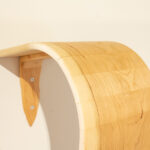On Tuesday, February 7, Robert Rindler, President of the Milwaukee Institute of Art & Design, addressed the Rotary Club of Milwaukee. He talked about why he came to MIAD, what MIAD does, and the crucial role that creative problem solvers will play in the economy of the future.
Thank you, [MIAD Trustee] Linda [Stephenson], for that great introduction. I am so pleased to be here with you this afternoon.
As you have heard, I am new to Milwaukee – indeed the Midwest – and am delighted to report that coming here is the best thing I have ever done. My life has taken on a new sense of importance as I rise to the charge of leading the Milwaukee Institute of Art & Design into the next evolutionary stage of its future. This past fall marked my 53rd year in a row returning to school – every year since kindergarten – as a student, teacher, dean, provost and now president, and as I say to my good friends, I am not about to sit in the back of the room and get a C in this class.
I thought that rather than looking at me while I speak, I would provide you with a visual tour through MIAD’s studios and classrooms. These images are really in no particular order, and they will not specifically illustrate my comments but rather will provide you, I hope, with a context for my remarks. The images include MIAD’s facilities, students, some of the results of the students’ work and an insight into life for these young people while in our charge.
The Milwaukee Institute of Art & Design is Wisconsin’s only professional, independent college devoted solely to the education of artists and designers. MIAD is accredited to offer the bachelor of fine arts degree in 11 majors: communication design, drawing, illustration, industrial design, integrated studio arts, interior architecture + design, painting, photography, printmaking, sculpture and time-based media. As such, it is one of the Midwest’s leading producers of the creative class of the future for our nation.
Our history
MIAD is an evolutionary outgrowth of the former legendary Layton School of Art. After the Layton’s doors closed, seven former faculty members had the visionary idea to each contribute $100 and work without compensation for three years to establish the Milwaukee Institute of Art & Design in 1974. MIAD has been in three locations and moved to its current building on the river on Erie Street in the Historic Third Ward in 1992, providing anchoring stability to what was then perceived by many as an undesirable location. How wrong they were!
The building is an extraordinary laboratory for creative problem solving that is almost 250,000 square feet with five floors each 11/2 times the size of a football field. (I have been told that this would be an easily identifiable context for all of you here in Wisconsin.) It has 14 state-of-the art computer and digital technology studios and unbelievably expansive and beautiful painting and drawing studios directly overlooking the Milwaukee River. Our 3D laboratory provides students the opportunity to work in wood, metal and plastic, among other materials, and through processes including vacuum molding, modeling and metal casting using machinery of almost every type, to support the manufacture of individual, unique and prototypical projects in any media. Our newly renovated digital and time-based media lab has almost entirely replaced the water-dependent chemical process in photo and film production, and interest in video, no surprise here, is at an all-time high.
Our students
Tuition at MIAD is currently almost $23,000 per year, and a majority of our student body consists of first-time college students who are meeting this expense through scholarships, loans and other financial aid programs. MIAD’s $14 million annual budget is mostly tuition supported, but we depend on the recognition and generosity of our friends, neighbors, and corporate and foundation partners to provide an additional $2 million each year to our annual fund. Not an easy task these days.
Our undergraduate program has 650 matriculating students, divided equally between men and women. MIAD currently has more than 30 international students and another 40 for whom English is a second language. These students represent 15 different countries, for a total of 10% of our student body. Almost 20% of our students are minorities and our student population comes to us from 25 different states in our country. 40% of our students made the Dean’s List this fall. Our faculty and professional academic support staff consists of more than 150 artists, designers and scholars, each serving as a mentor for these future leaders.
Our curriculum
In addition to the requirements in the major, students are also required to take almost 1/3 of the credits needed to graduate in liberal studies, including science, history and literature. For students interested in business, foreign languages and other less traditional humanities electives, we have an active and popular cross registration agreement with Marquette and Concordia Universities, and are establishing the same opportunities for our students with the Milwaukee School of Engineering.
Our exemplary Service Learning program, initiated by our liberal studies faculty, has operated for the past 4 1/2 years and is unprecedented in any art and design college in the United States. It is now a requirement that each matriculating undergraduate, as a degree requirement, perform 40 hours of volunteer service during the junior year in one of more than 100 agencies throughout Southeast Wisconsin. We estimate that in the short time this requirement has existed, our students have contributed more that 30,000 hours and approximately half a million dollars in volunteer support within our community. Some of the most popular and important placements have been in the Wisconsin Humane Society, the Urban Ecology Center, the Audubon Nature Center, almost every Milwaukee Public School, La Causa Crisis Nursery, Sojourner Truth House, the Milwaukee Rescue Mission, the Indochinese Learning Center, Milwaukee Achiever Literacy services, and homeless and domestic abuse shelters, programs for special needs children and adults, ESL tutoring programs and countless other social service areas in our region.
The most important component of this work is that it is accomplished as part of a required academic course offered for credit, and involves research into the issues behind the need for volunteers in the community. Students must provide both a written report and an illustrated oral presentation on their work, and their sponsors often come to MIAD to be part of the public final class presentation.
Our creative class – the brain gain
Approximately 60% of our juniors and senior students serve as interns at local corporations, businesses and organizations throughout the Greater Milwaukee area, and almost all others work part-time or do freelance work in their profession, in such businesses as Quad Graphics, Nike, Sony, Hallmark, Kohler, Target, Trek Bicycles, Whirlpool, Lego, and at each and every museum and theater company in the region. Within a year of graduation, our alumni surveys inform us that 95% of our graduates are employed, with 85% of these people reporting that they are working in a creative field that provides strong and meaningful job satisfaction. Almost 1/3 of our graduates report that they have freelance clients, and many manage or own their own creative businesses.
I have begun to identify MIAD as the major supplier of the creative capital our region needs: the “brain gain” for Milwaukee, as opposed to the “brain drain.” Less than 60% of our students come from the greater Wisconsin area, but 80 % of them stay in or near Milwaukee to make their home and to design productive, meaningful lives for themselves and their families.
With close to 2,000 alumni, 1,500 of whom work in the state, MIAD is the largest source of visual art professionals in Wisconsin.
Economist Richard Florida calls them the “creative class.” We call them alumni. They are the web designers, graphic and communication designers and associated professionals who constitute the fastest growing portion of our economy in the United States and here in Wisconsin. More that 1,000 MIAD alums work in the local communication and graphic design industry. Their brochures, print and TV ads, websites, signage and billboards help propel local commerce, and all of their publications keep you informed about the state of our culture and economy. From the art direction for Milwaukee Magazine to the design of the Milwaukee Art Museum’s logo, MIAD grads are all around you.
Graduates of our interior architecture + design and industrial design programs carry on the tradition of Brooks Stevens, who taught at MIAD for many years. Our alumni work in the creative design departments of hundreds of local businesses, such as GE Medical, Buell, Harley Davidson and Rockwell.
Alumni from our fine arts programs are now staying in Milwaukee in record numbers, having discovered the incredible opportunities a supportive creative community can offer. Their work is exhibited in almost every major gallery in Milwaukee and Wisconsin, and in museums, public spaces, offices and homes throughout the region and beyond. Most of the major national museums and galleries have exhibited the work of MIAD alumni and our outstanding faculty and visiting artists.
Our community outreach
MIAD also has very popular continuing education and public program components. We mount exhibitions and hold panel discussions, symposia and lectures of intellectual and aesthetic interest to our own community and the general public throughout the year; and we invite each of you to visit as an active consumer of the cultural landscape we celebrate within our facilities.
We offer approximately 150 courses in life-long learning in the arts and design to more than 1,500 registered adult students each year, and approximately 400 local high school students participate in more than 40 pre-college classes. 14% of our entering freshmen class this year attended these programs. We also welcome an additional 500 outreach and special program students of all ages into the studios, laboratories and classrooms on Saturdays and during the summer.
Our future leaders
According to data compiled by the College Board Art and Science group, from 1996-2005, there has been a 44% increase in the number of high school seniors who say that they plan to major in the visual arts and design. For business and commerce majors, the increase was only 12%, while the percentage that plans to major in the social sciences and history increased by 15% for this same period. This is indeed something for those of us who are in the education business to note. More and more of our young people are embracing the notion of being an active participant in the evolution of our culture and in the purpose of a fulfilling life well-lived and marked by intense personal meaning, value and satisfaction.
Nearly 1/2 of the jobs that will be available to children entering kindergarten this year, when they graduate from college in15 years, do not currently exist. We, as a nation, have to ask ourselves how we are educating our young people. Are we just providing them with skills and teaching them how to do something (an important outcome of a good education certainly), or is the way we currently perform these tasks going to evolve into obsolescence in the future? Are we educating them to be creative stakeholders in the future of our culture and our society – young people who will feel empowered to be passionate, committed and self-assured to be the creative problem solvers for whatever our growing global economy will throw at them today and in the future? Can we feel assured that they will be intellectually curious and prepared to address, perhaps attack head on, any problem they encounter from a secure place of knowledge and also, yes skill, with the power to transcend definitions and boundaries that will surely be redefined again and again in their lifetime?
Recent articles illuminating research right here in Wisconsin on the arts and the economy highlights the fact that creativity underpins the jobs and communities for the 21st century. We must ask our institutions of higher learning to work to develop the economic, educational and civic vitality of Wisconsin by investing in its creative economy – its future leaders.
We have all read recently that B Schools are now looking at D Schools – that’s business schools looking to design schools – to learn from them the process and power of approaching creative thinking and problem solving from a theoretical, conceptual base. It is no longer enough to teach our young people who will inherit our world to know how to do something or to make something, it is now most important to empower them to be something. And that something, the ability to truly be all you can be, is profoundly influenced by an enlightened understanding of the value of commitment, curiosity and talent for embracing change, and most of all, hard work.
I am here to tell you that art is work. It can and should be fun, in the way that only our most productive moments provide pure joy and satisfaction. But it is in instilling in the next generation the core value of working hard, long, passionately and with an ever- expanding vision of our evolving culture that they, and we, will move ahead independently in our own lives, and collectively, here in Milwaukee, Wisconsin and the world.
I am delighted and proud to say that I see every day in every corner of the Milwaukee Institute of Art & Design the power of the creative human spirit to reach new and continually redefined goals for our future. We are indeed in good hands. The challenges, known and unknown, will come at us directly and continually. But if we provide the opportunity for our future leaders to believe in themselves as our new, truly creative class, poised, prepared and excited to take on our future, we have fulfilled our own legacy to make sure our world is just one bit better tomorrow than it is today. This is indeed, for me, at the heart of education – and an enlightening, empowering experience we must continue to provide for our children for our future.





